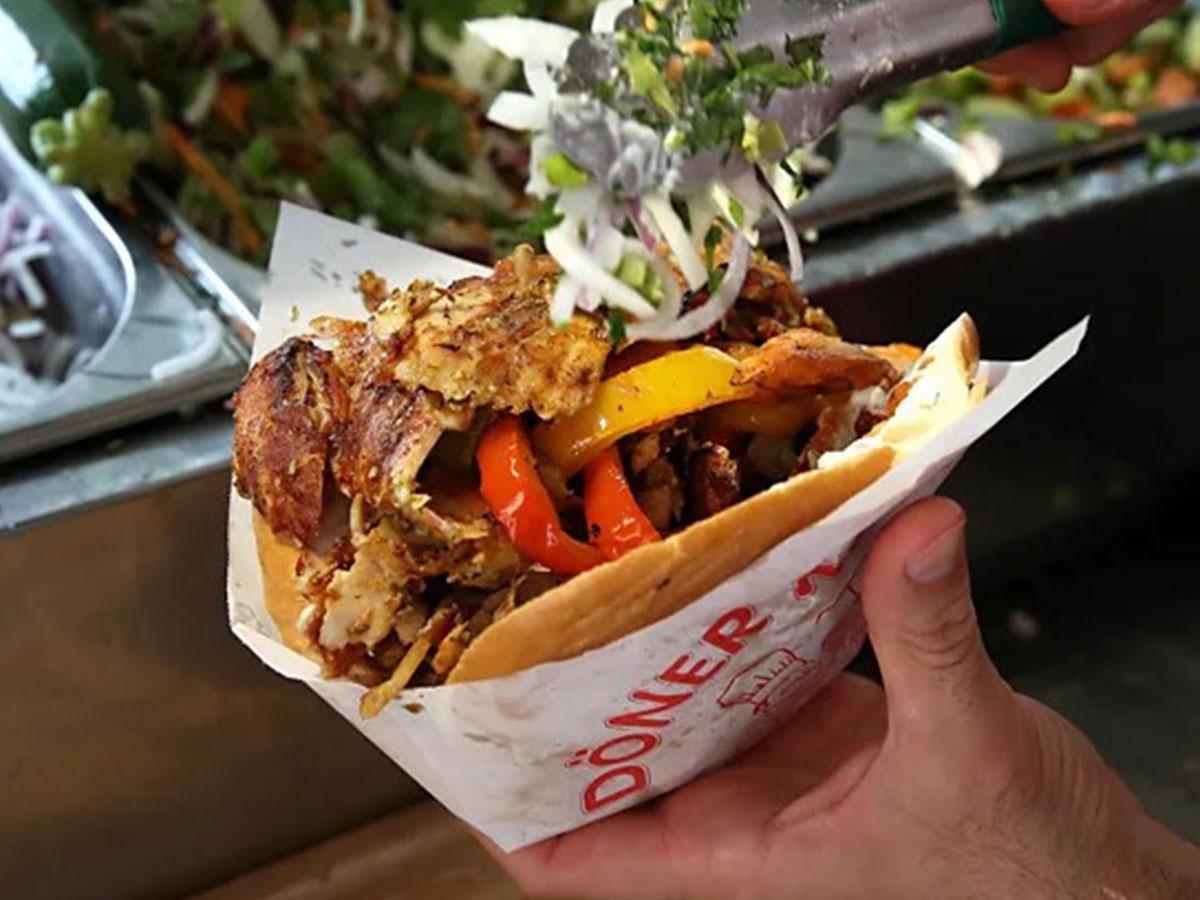
Whose Döner Kebab? Why the Beloved Late-Night Snack is at the Center of a Meat-Fuelled Food Fight
The Turkish government has made headlines by seeking to have the döner kebab officially recognized as a Turkish specialty, igniting a spirited debate in Germany, where the döner has become an iconic and beloved late-night snack.
Berliners have long embraced the döner kebab, a favorite among office workers seeking a quick bite, schoolchildren on their way home, and revelers moving between nightlife venues. What draws so many to döner shops throughout the city? It’s the enticing layers of spiced beef, slow-cooked on a vertical spit, shaved into thin slices, and packed into pita bread with fresh, crunchy salad. Often topped with garlic-flavored yogurt sauce, it’s a German twist on Turkey’s traditional döner, where the meat is typically served on a plate with rice and salad.

However, if the Turkish government’s application to the European Commission succeeds, the roughly 1,000 döner kebab shops in Berlin alone could face restrictions on using the term “döner kebab.” Turkey wants the dish recognized as a Turkish specialty, similar to Italy’s Neapolitan pizza or Spain’s Serrano ham, with strict criteria for what constitutes a “true” döner kebab. Under this proposal, Berlin’s portable version might not make the cut.
Germany’s Federal Ministry of Food and Agriculture (BMIL) has joined 10 other organizations in filing an objection, expressing surprise at Turkey’s request. A spokesperson told the BBC, “The döner kebab is part of Germany, and the diversity of its preparation methods reflects the diversity of our country – this must be preserved. We are committed to ensuring that the döner kebab can remain as it is prepared and eaten here, in the interests of its many fans.”
Visit Berlin notes that the popular Berlin döner, which spread across Germany, was first created in the early 1970s. Two men, Mehmet Aygün and Kadir Nurman, both members of the Turkish “guest worker” community that helped drive Germany’s post-war economy, are credited with adapting the traditional Turkish döner into the easy-to-eat sandwich that has become an economic powerhouse. In Germany alone, döner sales are estimated to bring in approximately €2.3 billion annually, with €3.5 billion across Europe, according to the Berlin-based Association of Turkish Döner Producers in Europe.
Politicians in Germany have even used the döner as a tool for political points. The left-wing party Die Linke proposed introducing a döner price cap (Dönerpreisbremse) earlier this year to help keep prices accessible, though the government ultimately declined.
The success of the döner in Germany is a testament to the hard work and dedication of the Turkish immigrant community, according to Deniz Buchholz, the half-German, half-Turkish co-owner of Berlin’s Kebap with Attitude. He says these workers received little recognition as they passed recipes “from mouth to mouth.” His restaurant takes a modern twist on the classic döner, with options like Funky Mango, featuring chicken, mango-cranberry chutney, and sesame-coriander pesto; Vallah Vegan, a vegan version made with plant-based meat, cauliflower, and pomegranate; and the Truffle Delüks, which includes beef, green asparagus, roast potatoes, and truffle shavings.
However, these contemporary takes wouldn’t meet the Turkish proposal’s strict requirements, which mandate that döner slices must be 3-5mm thick and come from beef that’s at least 16 months old. The marinade should include specific amounts of animal fat, yogurt or milk, onion, salt, thyme, and three types of pepper.
Not everyone supports a rigid definition. Culinary historian Mary Işın, who has extensively studied Turkish cuisine, says the döner has evolved within Turkey over the years. She recalls that in the 1970s, döner in Turkey was usually made with lamb, not beef, and accompanied by a simple garnish of sliced onions rather than today’s additions like tomatoes and peppers.

Işın has traced the kebab’s history in her paper Ottoman Kebab Culture and the Rise of the Döner Kebab, where she notes that the term “döner kebab” only appears in Ottoman texts as of 1908. Still, depictions of horizontally spit-roasted döner kebabs exist as far back as the 17th century in miniature paintings within Turkish translations of the Persian epic Shahnama. Though references to the dish in historical sources are scarce, by the 19th century, foreign tourists were documenting the döner kebab in their travels. Işın suggests the dish was likely so common in the Ottoman Empire that local sources saw no reason to note it.
Ottoman cuisine was rich with various kebabs, including şiş kebabı (mutton on a skewer) and tandır kebabı (oven-roasted meat). The döner, with meat stacked on a vertical spit (the word “döner” derives from the Turkish word for “turning”), initially began as a picnic favorite.
A 1433 account from French traveler Bertrandon de la Broquiere offers an early description of the method that led to döner’s eventual form. He wrote about Turkish travelers roasting an entire sheep and cutting slices from the exterior as it cooked, which Işın points out is practical when cooking a whole sheep on a spit – you wouldn’t want to wait hours for it to finish.
The European Commission has asked both the Turkish and German governments to negotiate a compromise. If Turkey’s proposal is accepted, the impact could extend worldwide, as döner has become one of Turkey’s most famous culinary exports.

In Sydney, Ülkü Gani, who runs Turkish food tours, remembers helping her parents prepare kebabs at local markets. She recalls, “My father would mix spices with mince and layer it with thin slices of steak – that 50kg kebab would hold together because of those layers of steak.” Their kebabs were similar to the classic Berlin döner, served with tomato, lettuce, onions, and a choice of sauces, including a yogurt-based one.
“The flavor in Turkish cuisine highlights the main ingredient without overpowering it with too many spices,” says Gani. This restraint, she notes, applies not just to kebabs but to dishes like sarma (cabbage rolls), found in countries like Ukraine and Bulgaria, and dolma (stuffed grape leaves), which are also popular in Greece.





